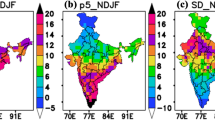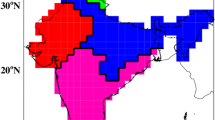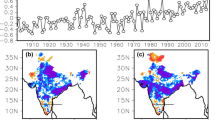Abstract
A retrospective analysis of 17 years of NCMRWF Global Forecast System (NGFS) data was conducted to understand the state and variability of cold wave episodes over northwest India. During the 2000–2016 period, a total of 21 cold wave episodes (202 cold nights) were detected, out of which 5 severe cold episodes (63 cold nights) were registered. The 10 (6) episodes occurred during La Niña (El Niño) years suggesting that both phases of El Niño-Southern Oscillation provide a favourable background for the occurrence of cold waves. The average duration of a cold wave episode was ~ 9.6 days, with the longest (shortest) episode, seen in the year 2008 (2006), lasting for 26 (6) consecutive days. The average duration of a severe cold wave episode is ≈ 4 days longer than that of a normal cold wave. In the year 2005, both the earliest (11 December) and latest (16 February) onsets of cold waves were seen. The omnipresence of intense Siberian anticyclone and the presence of western disturbance brought cold winds to the study region. Also, temperature advection and geo-potential height anomalies play vital roles in the maintenance of cold waves. The cold waves exhibit a significant intra-annual variability over northwest India. The intensity of cold waves has shown an increase of 0.11 °C per cold episode.







Similar content being viewed by others
References
Bedekar, V. C., Dekate, M. V., & Banerajee, A. K. (1974). Heat and cold waves in India, Forecasting Manual Report, Part IV-6 (pp. 1–63). India: India Meteorological Department.
Bedi, H. S., & Parthasarathy, B. (1967). Cold waves over northwest India and neighbourhood. Indian Journal of Meteorology & Geophysics,18(3), 371–378.
Bhatla, R., Tabassum, S., & Tripathi, A. (2016). Trend analysis and extreme events of temperature during post monsoon and winter seasons over Varanasi, Uttar Pradesh, India. The Journal of Indian Geophysical Union,20(1), 123–127.
Chand, R., & Singh, C. (2015). Movements of western disturbance and associated cloud convection. The Journal of Indian Geophysical Union,19(1), 62–70.
Cheung, H. N., Zhou, W., Mok, H. Y., & Wu, M. C. (2012). Relationship between Ural-Siberian blocking and east Asia winter monsoon in relation to the Arctic Oscillation and the El-Niño Southern Oscillation. Journal of Climate. https://doi.org/10.1175/JCLI-D-11-00225.1.
Cohen, J., & Entekhabi, D. (1999). Eurasian snow cover variability and northern Hemisphere climate predictability. Geophysical Research Letters. https://doi.org/10.1029/1998gl900321.
De, U. S., Dube, R. K., & Prakasarao, G. S. (2005a). Extreme weather events over India in last 100 years. The Journal of Indian Geophysical Union,9(3), 173–187.
De, U. S., Singh, A., & Pandey, S. N. (2005b). Heat and cold waves affecting India during recent decades. International Journal of Meteorology,30(303), 323–331.
Guha-Sapir, D. G., Hoyois, Ph., & Below, R. (2013). Annual disaster statistical review 2012: The numbers and trends. Brussels: CRED. http://www.cred.be/sites/default/files/ADSR_2012.pdf.
Lim, Y. K., & Kim, H. D. (2013). Impact of the dominant large-scale teleconnections on winter temperature variability over east Asia. Journal of Geophysical Research Atmospheres. https://doi.org/10.1002/jgrd.50462.
Mahdi, S. S., & Dhekale, B. S. (2016). Long term climatology and trends of heat and cold waves over southern Bihar, India. Journal of Earth System Science,125(8), 1557–1567. https://doi.org/10.1007/s12040-016-0762-2.
Mahdi, S. S., Dhekale, B. S., Choudhury, S. R., Bangroo, S. A., & Gupta, S. K. (2015). On the climate risks in crop production and management in India: a review. Australian Journal of Crop Science,9(7), 585–595.
Pai, D. S., Srivastava, A. K., & Nair, S. A. (2017). Heat and cold waves over India. In M. Rajeevan & S. Nayak (Eds.), Observed climate variability and change over the Indian Region (pp. 57–71). New York: Springer. https://doi.org/10.1007/978-981-10-2531-0_4.
Pai, D. S., Thapliyal, V., & Kokate, P. D. (2004). Decadal variation in the heat and cold waves over India during 1971–2000. Mausam,55(2), 281–292.
Prasad, V. S., Johny, C. J., Mali, P., Sanjeev, S. K., & Rajagopal, E. N. (2017). Retrospective analysis of NGFS for the years 2000–2011. Current Science,112(2), 370–377. https://doi.org/10.18520/cs/v112/i02/370-377.
Raghavan, K. (1967). Climatology of severe cold waves in India. Indian Journal of Meteorology & Geophysics,18(1), 91–96.
RaiSircar, N. C., & Datar, S. V. (1963). Cold waves in northwest India. Indian Journal of Meteorology & Geophysics,14(3), 315–319.
Ratnam, J. V., Behera, S. K., Annamalai, H., Ratna, S. B., Rajeevan, M., & Yamagata, T. (2016). ENSO’s far reaching connection to Indian cold waves. Scientific Reports,6, 37657. https://doi.org/10.1038/srep37657.
Riaz, S. M. F., Iqbal, M. J., & Baig, M. J. (2018). Influence of Siberian High on temperature variability over northern areas of South Asia. Meteorology and Atmospheric Physics,130, 441–457. https://doi.org/10.1007/s00703-017-0531-z.
Samra, J. S., Singh, G., & Ramakrishna, Y. S. (2003) Cold wave of 2002–03—Impact on agricultural. Information Bulletin ICAR, pp 1–62.
Sandeep, A., & Prasad, V. S. (2018). Intra-annual variability of heat wave episodes over the east coast of India. International Journal of Climatology. https://doi.org/10.1002/joc.5395.
Subbaramayya, I., & Surya Rao, D. A. (1976). Heat wave and cold wave days in different states of India. Indian Journal of Meteorology, Hydrology & Geophysics,27(4), 436–440.
Yang, S., Lau, K. M., & Kim, K. M. (2002). Variations of the east Asian jet stream and Asian-Pacific-American winter climate anomalies. Journal of Climate. https://doi.org/10.1175/1520-0442(2002)015%3c0306:voteaj%3e2.0.co;2.
Acknowledgements
We would like to thank anonymous reviewers for their valuable suggestions and comments, which helps in improving the manuscript. We also thank Dr. E. N. Rajagopal (Head, NCMRWF) for his valuable encouragement.
Author information
Authors and Affiliations
Corresponding author
Additional information
Publisher's Note
Springer Nature remains neutral with regard to jurisdictional claims in published maps and institutional affiliations.
Rights and permissions
About this article
Cite this article
Sandeep, A., Prasad, V.S. On the Variability of Cold Wave Episodes Over Northwest India Using an NGFS Retrospective Analysis. Pure Appl. Geophys. 177, 1157–1166 (2020). https://doi.org/10.1007/s00024-019-02335-9
Received:
Revised:
Accepted:
Published:
Issue Date:
DOI: https://doi.org/10.1007/s00024-019-02335-9




